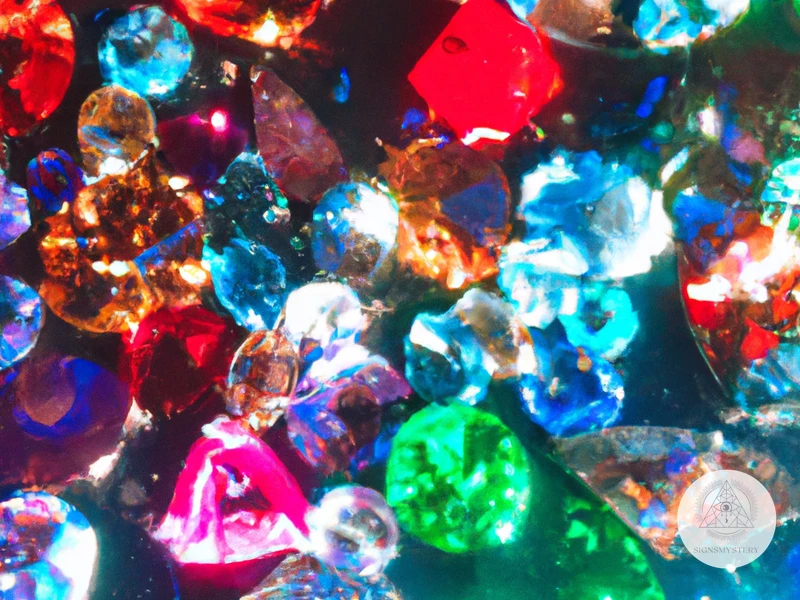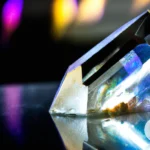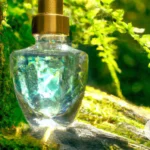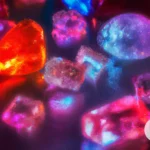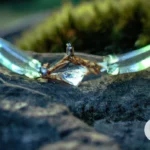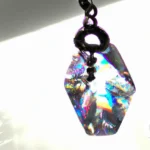Crystals have captivated and intrigued people for centuries, with their shimmering beauty and purported metaphysical properties. But alongside the genuine crystal market, a parallel market for fake crystals has emerged, leaving consumers perplexed and searching for answers. In this comprehensive guide, we delve into the world of fake crystals, exploring the reasons behind their popularity, the rise of the market, and how to spot and avoid purchasing these imitations. Whether you’re a crystal enthusiast, a curious observer, or someone looking to invest in authentic crystals, understanding the market for fake crystals is essential. So, let’s embark on this journey to uncover the truth about the dazzling but deceptive world of fake crystals.
The Appeal of Crystals
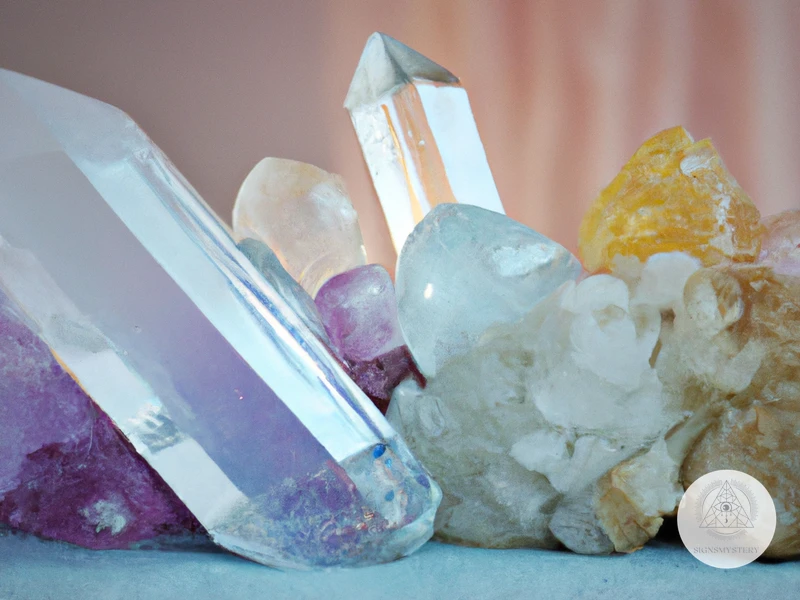
Crystals hold a timeless appeal, captivating individuals from all walks of life. Each crystal possesses a unique energy and beauty that draws people in and entices them to explore further. The appeal of crystals can be attributed to several factors that make them highly sought after.
1. Connection to Nature and Spiritual Beliefs: Crystals are believed to contain the energy of the Earth, forging a deep connection between humans and nature. Many spiritual traditions and practices incorporate crystals as tools for healing, meditation, and spiritual growth. People are drawn to crystals as a means to connect with something greater than themselves and tap into the natural energies that surround us.
2. Aesthetic and Decorative Purposes: True works of art, crystals are prized for their visual appeal. From their vibrant colors to their unique formations, crystals make captivating decorative pieces. Whether they adorn a shelf, a necklace, or a mystical altar, crystals add a touch of elegance and beauty to any space. Their ability to catch and refract light adds a mesmerizing sparkle, further enhancing their aesthetic appeal.
3. Healing and Holistic Practices: Crystals are believed to possess various healing properties and can be used as tools to support physical, emotional, and spiritual well-being. Different crystals are associated with different healing properties, such as calming anxiety (link to /importance-of-chakra-balance-with-crystals/), enhancing focus and clarity, boosting creativity, and promoting balance and harmony. Many individuals turn to crystals as an alternative or complementary therapy to promote wellness and healing.
In conclusion, the appeal of crystals is multifaceted, encompassing a deep connection to nature, their aesthetic allure, and their potential healing properties. These factors contribute to their enduring popularity and the desire to incorporate them into various aspects of life. Whether driven by spirituality, aesthetics, or the pursuit of holistic healing, individuals are drawn to crystals as a means to enhance their well-being and explore the mystical world they embody.
1. Connection to Nature and Spiritual Beliefs
Crystals have long been associated with a deep connection to nature and spiritual beliefs, making them highly sought after by individuals seeking a greater sense of harmony and alignment. Many spiritual traditions recognize the Earth as a source of powerful energies, and crystals are believed to be conduits for these energies. They are seen as tangible representations of the Earth’s energy and can help individuals tap into the natural world around them.
When using crystals in a spiritual context, individuals often choose stones that align with specific intentions or energies they wish to cultivate. For example, amethyst is often used for its calming and protective qualities, while rose quartz is associated with love and compassion. By incorporating crystals into meditation, prayer, or energy work, individuals believe they can enhance their connection to higher powers or their own inner spirituality.
Crystals are revered for their ability to absorb and amplify energies. They are believed to harness the spiritual essence of the Earth and can aid in grounding, balancing, and aligning one’s energy centers (link to /science-crystal-elixirs-essences/). This connection to nature and spiritual beliefs is not limited to specific cultures or religions but spans across various spiritual practices worldwide.
Crystals also serve as reminders of the beauty and power of the natural world. They are tangible expressions of the Earth’s geological wonders and remind individuals of the vastness and intricacies of the universe. Holding or wearing crystals can provide a sense of comfort and reassurance, serving as a grounding force in times of stress or uncertainty.
The connection between crystals, nature, and spiritual beliefs is a fundamental aspect of their appeal. Crystals are seen as bridges to the natural world and tools for spiritual exploration and growth. Whether used in meditation, energy work, or simply as reminders of the Earth’s beauty, crystals hold a sacred place in many individuals’ spiritual journeys and provide a tangible link to the wonders of the universe (link to /cleanse-recharge-tigers-eye-crystals/).
2. Aesthetic and Decorative Purposes
Crystals are not only valued for their metaphysical properties, but they also serve as exquisite decorative pieces. Their aesthetic appeal lies in their unique formations, vibrant colors, and dazzling sparkle. Here are a few reasons why crystals are sought after for aesthetic and decorative purposes:
1. Variety of Shapes and Colors: Crystals come in a wide array of shapes and colors, making them versatile for different decorative styles. From the delicate points of clear quartz to the smooth, rounded forms of rose quartz, each crystal offers a distinct visual element. The colors range from the deep blues of sodalite to the purples of amethyst and the iridescent hues of labradorite. This diversity allows individuals to choose crystals that complement their personal style and the aesthetics of their living spaces.
2. Enhancing Interior Design: Crystals can elevate any interior design, whether contemporary, bohemian, or minimalist. Placing crystals strategically in a room can create focal points or accentuate existing decor. Large geodes or clusters can serve as stunning centerpieces on a coffee table or mantel, while smaller crystals can be displayed on shelves, in bowls, or in glass terrariums. Their natural beauty adds a touch of elegance, creating a visually captivating environment.
3. Bringing Positive Energy: Crystals are believed to emit positive energy and vibrations. Incorporating them into home decor is thought to infuse spaces with harmony, tranquility, and balance. This can create a calming atmosphere and promote a sense of well-being. Many individuals choose to display a particular crystal, such as clear quartz or citrine, in areas associated with specific intentions, such as abundance or clarity of thought.
4. Jewelry and Accessories: Crystals are not limited to home decor; they also make stunning jewelry and accessories. Whether adorning a pendant, a bracelet, or a pair of earrings, crystals add a touch of elegance and uniqueness to personal style. Wearing crystals allows individuals to carry their energy throughout the day and showcase their beauty in a wearable form.
The aesthetic and decorative appeal of crystals lies in their variety of shapes, vibrant colors, and positive energy. Whether displayed as decorative pieces in a living space or worn as jewelry, crystals enhance visual appeal and contribute to a sense of harmony and well-being. Their versatility and beauty make them a popular choice for individuals looking to infuse their surroundings with elegance, uniqueness, and positive vibrations.
3. Healing and Holistic Practices
Crystals have long been associated with healing and holistic practices, serving as powerful tools in various therapeutic modalities. The belief in the energetic properties of crystals is rooted in ancient civilizations and continues to be embraced by many today.
1. Energy Healing: Crystals are believed to emit vibrational frequencies that interact with the body’s energy field, promoting balance and harmony. Practitioners of energy healing modalities, such as Reiki or crystal healing, use specific crystals to channel and direct energy, facilitating healing on physical, emotional, and spiritual levels. Different crystals are thought to resonate with specific chakras or energy centers, helping to clear blockages and restore energy flow.
2. Meditation and Mindfulness: Crystals serve as aids in meditation, helping individuals achieve a deeper state of focus and relaxation. Meditating with crystals can enhance mindfulness practices by providing a tangible focal point and promoting a sense of grounding. The unique energy of each crystal is believed to support different aspects of meditation, such as calming the mind (link to /importance-of-chakra-balance-with-crystals/) or enhancing spiritual connection.
3. Crystal Elixirs and Essences: Crystal elixirs and essences are infusions made by immersing crystals in water or other liquids. It is believed that the energy and properties of the crystals can be transferred into the liquid, creating a potent remedy. These elixirs can be consumed internally or applied topically to support physical and emotional well-being. However, caution should be exercised when ingesting crystal elixirs, as not all crystals are safe for internal use (link to /science-crystal-elixirs-essences/).
4. Crystal Grids: Crystal grids involve arranging multiple crystals in specific geometric patterns to amplify their individual properties and create a harmonious energy field. Grids can be used for various purposes, such as manifesting intentions, enhancing abundance, or promoting emotional healing. The placement and combination of crystals in a grid work together synergistically to create a focused and amplified energy.
5. Spiritual Connection and Intuition: Crystals are often used as tools for enhancing spiritual practices and deepening intuitive abilities. They are believed to enhance one’s connection to higher realms, guides, and divine energies. Some individuals use crystals during divination practices, such as tarot readings or pendulum work, to access higher wisdom and guidance.
Healing and holistic practices involving crystals are based on the belief that these gems possess unique properties and energies that can support well-being on multiple levels. Whether utilized in energy healing, meditation, elixirs, grids, or for spiritual connection, crystals provide individuals with a tangible means of accessing and harnessing their inherent power. It’s important to approach crystal healing practices with an open mind and respect for their potential, understanding that they are complementary tools that can support overall well-being.
The Rise of Fake Crystals
The rise of fake crystals has taken the market by storm, leaving many consumers unaware that what they are purchasing is not the genuine article. There are several key factors contributing to the increase in fake crystals flooding the market.
1. Increased Popularity and Demand: As the popularity of crystals has surged in recent years, so too has the demand for them. This increased demand has created a lucrative market for fake crystals. Unscrupulous individuals and companies see an opportunity to capitalize on the trend, mass-producing imitation crystals that closely resemble the real thing.
2. Lack of Regulation in the Industry: The crystal market is largely unregulated, making it easier for fake crystals to infiltrate the market. Without strict standards or guidelines, it can be challenging for consumers to differentiate between genuine and fake crystals. This lack of regulation allows counterfeiters to thrive and continue to deceive unsuspecting buyers.
3. Profit Motive behind Fake Crystals: The profit margin associated with fake crystals is considerably higher than that of genuine crystals. By using inexpensive materials and mass production techniques, counterfeiters can produce fake crystals at a fraction of the cost of genuine ones. This financial incentive drives the production and distribution of fake crystals, flooding the market with cheap imitations.
In this landscape of increasing popularity, lack of regulation, and profit motive, it becomes more important than ever for consumers to educate themselves and be able to distinguish between real and fake crystals. By understanding the rise of fake crystals and the motivations behind it, individuals can make informed choices when purchasing these beautiful and energetically significant objects.
1. Increased Popularity and Demand
Increased Popularity and Demand: The market for fake crystals has seen a significant rise in recent years, largely due to the increased popularity and demand for crystals in general. There are several reasons behind this surge in interest, contributing to the growth of the fake crystal market.
1. Trendy and Fashionable: Crystals have become a popular fashion statement, with celebrities, influencers, and fashion-forward individuals incorporating them into their outfits and accessories. This trendiness factor has contributed to the increased demand for crystals, making them more mainstream and accessible to a wider audience.
2. Social Media Influence: Social media platforms have played a crucial role in amplifying the popularity of crystals. Instagram, Pinterest, and TikTok are filled with aesthetically pleasing posts showcasing crystals, their properties, and their uses. Influencers and enthusiasts share their experiences, creating a sense of fascination and allure around crystals. This virtual exposure has piqued the curiosity of many, leading to a surge in demand.
3. Wellness and Self-Care Movement: The growing interest in wellness and self-care practices has fueled the popularity of crystals. Many individuals are seeking alternative methods to promote well-being and balance in their lives. Crystals, with their purported healing properties, offer a holistic approach to self-care that resonates with this movement. As a result, people are actively seeking out crystals as tools for relaxation, meditation, and personal growth.
4. Accessibility and Affordability: As the interest in crystals has grown, so has the number of vendors and sellers catering to this demand. Crystals are now readily available in various price ranges, making them more accessible to a wider audience. The affordability factor has also contributed to the increased popularity, as individuals can experiment with crystals without breaking the bank.
In conclusion, the rising popularity and demand for crystals have resulted in a parallel market for fake crystals. The trendy nature of crystals, the influence of social media, the wellness movement, and increased accessibility have all played a role in fueling this growth. As consumers navigate this market, it is crucial to be aware of the factors driving the demand for fake crystals and to equip oneself with the knowledge to distinguish between genuine and imitation crystals.
2. Lack of Regulation in the Industry
Lack of Regulation in the Industry: One of the key factors that has contributed to the rise of fake crystals in the market is the lack of regulation within the industry. Unlike other industries where strict quality control and authentication standards are in place, the crystal market operates with few regulations and oversight. This creates an environment where unscrupulous individuals can easily introduce fake crystals into the market.
Without industry-wide standards for testing and certifying the authenticity of crystals, it becomes challenging for consumers to differentiate between genuine and fake crystals. Manufacturers and sellers take advantage of this lack of regulation to produce and market imitations that closely resemble the real thing. These fake crystals are often made using low-quality materials or synthetic substances that mimic the appearance and properties of genuine crystals.
Additionally, the lack of regulation also extends to the labeling and marketing of crystals. Some sellers may intentionally misrepresent their products, labeling fake crystals as genuine or using misleading terms to make their products seem more valuable or rare. This deception can mislead unsuspecting buyers who may not have the knowledge or experience to distinguish between real and fake crystals.
The absence of regulatory bodies or governing organizations makes it difficult for consumers to trust the authenticity of crystals they encounter in the market. It is essential for consumers to educate themselves and rely on reputable sources when purchasing crystals to avoid falling victim to the proliferation of fake crystals.
3. Profit Motive behind Fake Crystals
The market for fake crystals has seen a significant rise due to the profit motive that drives sellers and manufacturers. There are several factors that contribute to the profit motive behind the production and sale of fake crystals.
1. Lower Production Costs: Creating fake crystals is often much cheaper than extracting or mining genuine crystals. Manufacturers can use inexpensive materials like glass or plastic and mimic the appearance of real crystals through various methods. This allows them to produce large quantities of fake crystals at a fraction of the cost, resulting in higher profit margins.
2. Exploitation of Demand: With the increasing popularity of crystals, there is a growing demand for them in the market. This demand creates an opportunity for unscrupulous individuals to take advantage of consumers who may not have the knowledge or expertise to differentiate between real and fake crystals. By selling fake crystals as genuine, these sellers can exploit the demand and make substantial profits.
3. Lack of Regulation: The lack of regulation in the crystal industry contributes to the profit motive behind fake crystals. Unlike other industries that have strict guidelines and standards, the crystal market remains largely unregulated. This allows counterfeiters to operate with relative ease and avoid detection. The absence of a governing body or certification process makes it easier for fake crystals to penetrate the market, deceiving unsuspecting buyers.
4. Online Selling Platforms: The rise of online marketplaces and social media platforms has provided a convenient and anonymous platform for the sale of fake crystals. Sellers can easily create listings or accounts, showcasing their products to a wide audience. The anonymity of online transactions makes it even more challenging for buyers to verify the authenticity of the crystals they purchase.
The profit motive is a driving force behind the production and sale of fake crystals. Lower production costs, the exploitation of demand, the lack of regulation, and the rise of online selling platforms all contribute to the profitability of selling fake crystals. As consumers, it is essential to be aware of these factors and take necessary precautions to avoid falling victim to this deceptive market.
Spotting Fake Crystals
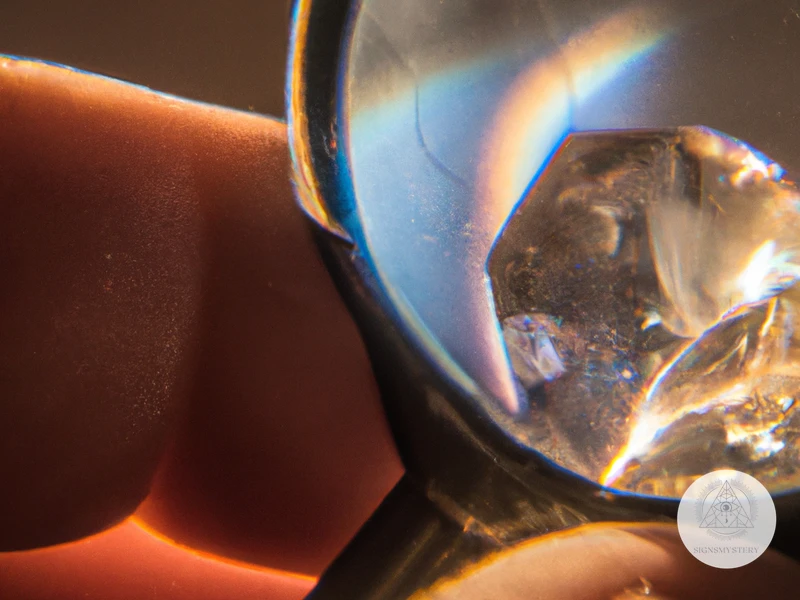
Identifying fake crystals can be a challenging task, as counterfeiters have become increasingly sophisticated in their craft. However, there are several key factors to consider when determining the authenticity of a crystal.
1. Examination of Appearance and Texture: Start by closely observing the crystal’s appearance and texture. Genuine crystals have a natural feel and may exhibit slight imperfections, such as small irregularities or inclusions. On the other hand, fake crystals often have a perfect, flawless appearance, lacking the organic qualities of real crystals.
2. Assessing Crystal Properties: Familiarize yourself with the properties of the specific crystal you are examining. Research and learn about its color, transparency, hardness, and other distinguishing characteristics. Compare these properties to those of a genuine crystal. If the crystal you are evaluating differs significantly in terms of its properties, it may be an indication of authenticity concerns.
3. Testing for Authenticity: Various tests can help determine if a crystal is genuine or fake. One common test involves conducting a scratch test using a known hardness scale (such as the Mohs scale). Genuine crystals have a specific level of hardness, and any significant deviation could indicate a counterfeit. Another test is the sound test, where you lightly tap the crystal and listen to the sound it produces. Authentic crystals typically generate a clear, resonant sound, while fake crystals may sound dull or artificial.
Remember, while these methods can provide helpful indicators, it is essential to approach crystal authenticity with caution. If you are uncertain about a crystal’s legitimacy, it is always recommended to consult with an expert or a trusted source before making a purchase.
1. Examination of Appearance and Texture
When it comes to spotting fake crystals, a careful examination of their appearance and texture is crucial. Here are a few key aspects to consider:
1. Color and Clarity: Genuine crystals come in a variety of colors, each with its unique energy and properties. Familiarize yourself with the natural color range of the crystal you’re interested in. Be cautious if you come across crystals that are in unnaturally vivid or extremely uniform colors, as this can be an indication of a fake. Additionally, examine the clarity of the crystal. Natural crystals may have natural inclusions or slight imperfections, while fake crystals tend to have a glass-like clarity.
2. Texture and Surface: Genuine crystals have a distinct texture that can vary depending on the type of crystal. Some crystals may have a smooth surface, while others might have natural crevices or etchings. Run your fingers along the surface of the crystal to feel its texture. Fake crystals often have a uniform, plastic-like feel and lack the intricate details found in natural crystals.
3. Weight and Temperature: Authentic crystals have a certain weight to them due to their mineral composition. While this method is not foolproof, comparing the weight of a crystal to its typical weight can help determine its authenticity. Additionally, natural crystals tend to feel cool to the touch due to their ability to absorb and release energy. Fake crystals may not have the same cooling effect or may feel unnaturally cold.
4. Crystal Structure and Growth Patterns: Crystals have a unique and identifiable internal structure. Research and familiarize yourself with the specific crystal structure of the type you’re interested in. Look for distinctive growth patterns, such as facets, terminations, or striations, which are indicative of natural crystal formation.
5. Sound and Resonance: Another method to assess the authenticity of a crystal is by tapping it lightly. Genuine crystals produce a clear and resonant sound, while fake crystals may sound dull or have a plastic-like sound.
By closely examining the appearance, texture, weight, temperature, crystal structure, and sound of a crystal, you can develop a discerning eye and be better equipped to spot fakes. Remember, it’s important to take multiple factors into consideration and to consult with experts or reputable sources when in doubt.
2. Assessing Crystal Properties
When it comes to assessing the properties of a crystal, there are several factors to consider. Here are some key points to help you evaluate the authenticity and quality of a crystal:
Color and Clarity: The color and clarity of a crystal can provide valuable insights into its authenticity. Genuine crystals often have a natural and consistent color, free from any obvious dyes or discoloration. While some crystals may have natural inclusions or imperfections, excessively cloudy or overly vibrant colors may be indications of synthetic or fake crystals.
Formation and Structure: Examining the formation and structure of a crystal can offer clues about its authenticity. Natural crystals tend to have distinct geometric shapes and well-defined crystal structures. Look for symmetrical patterns, smooth surfaces, and a crystalline appearance. Be wary of crystals that appear too perfect or have a uniform shape, as this could be a sign of artificial manufacturing.
Hardness and Density: Genuine crystals often have specific physical properties, such as hardness and density, that can be used to assess their authenticity. While conducting a hardness test may require specialized tools, you can get a sense of a crystal’s density by weighing it in your hand. Fake crystals may feel lighter or less substantial compared to genuine ones.
Energy and Vibration: Intuitively connecting with the energy and vibration of a crystal can also offer insights into its authenticity. Authentic crystals are believed to emit unique energies that can be felt or sensed by individuals sensitive to such vibrations. Take a moment to hold the crystal in your hand, close your eyes, and see if you sense any energetic or vibrational qualities.
Additional Testing: For a more conclusive assessment, you may consider using additional testing methods. Some techniques include using a blacklight to identify fluorescent properties, assessing the crystal’s response to temperature changes, or conducting a scratch test on less valuable crystals. However, it is important to note that these tests may not be foolproof and may require expert knowledge.
By carefully evaluating the color, clarity, formation, structure, hardness, density, and energy of a crystal, you can gain a better understanding of its properties and assess its authenticity. Remember that becoming knowledgeable about crystals and their characteristics takes time and practice, so don’t be discouraged. With experience, you will become more adept at spotting genuine crystals amidst the sea of fakes.
3. Testing for Authenticity
Testing for authenticity is crucial when it comes to crystals, as the market is flooded with fake imitations. There are several methods you can employ to determine whether a crystal is genuine or not.
1. Research and Knowledge: Educating yourself about the characteristics of different crystals is essential. Familiarize yourself with their colors, shapes, textures, and patterns. Genuine crystals often have unique formations and natural imperfections, while fake crystals may appear too perfect or uniform.
2. Visual Inspection: Examine the crystal closely, paying attention to its clarity. Genuine crystals may have slight inclusions or internal fractures, whereas fake ones are likely to be flawless. Additionally, observe the crystal’s color. Some crystals, like amethyst or citrine, may have vibrant hues, while others, like clear quartz, should be transparent with a slight tinge of color.
3. Weight and Temperature: Genuine crystals have a characteristic weight that can feel substantial in your hand. They also tend to be cooler to the touch since they are natural conductors of energy. Fake crystals, on the other hand, may feel lighter or have an artificially consistent temperature.
4. Crystal Properties: Research the metaphysical properties associated with the crystal you are examining. Genuine crystals are believed to possess specific energies and vibrations that can enhance different aspects of life. By comparing the effects and experiences associated with the crystal, you can validate its authenticity.
5. Seek Professional Guidance: If you’re unsure about a crystal’s authenticity, consider consulting with an expert or a reputable crystal dealer. They can offer insights into the characteristics and tell-tale signs to look out for, helping you make an informed decision.
6. Gemological Tests: In some cases, you may need to seek professional gemological testing to determine the authenticity of a crystal. These tests involve analyzing the crystal’s chemical composition and internal structure using specialized equipment. This method is often used for valuable gemstones rather than everyday crystals.
In conclusion, testing for authenticity requires a combination of research, visual inspection, and knowledge about crystal properties. By employing these methods, you can identify genuine crystals
Subscribe to Our Newsletter
Sign up to receive the latest news and updates.
The Market for Fake Crystals
The market for fake crystals has experienced a significant rise in recent years, fueled by various factors and contributing to a widespread availability of counterfeit products. Understanding the dynamics of this market is crucial for crystal enthusiasts and consumers who want to ensure the authenticity of their purchases.
1. Online Marketplaces and Websites: The internet has become a breeding ground for the sale of fake crystals. Online marketplaces and websites provide a platform for sellers to showcase and sell their products, often without proper regulations or authentication processes in place. This makes it easier for unscrupulous individuals to pass off fake crystals as genuine, targeting unsuspecting buyers who may not have the knowledge or tools to verify the authenticity of the crystals they are purchasing.
2. Physical Stores and Vendors: While online platforms dominate the fake crystal market, physical stores and vendors are not exempt from selling counterfeit products. Some stores may unknowingly source their crystals from unreliable suppliers or fail to conduct thorough authenticity checks. Additionally, certain vendors may intentionally sell fake crystals to unsuspecting customers to maximize profits. The lack of regulation and standardized practices in the industry make it challenging for consumers to differentiate between genuine and fake crystals.
3. Social Media and Influencers: Social media platforms have played a significant role in the promotion and sale of fake crystals. Influencers, who may not necessarily have expertise in crystals, often endorse and feature products without properly verifying their authenticity. The allure of social media influencers and their large followings can lead to an increased demand for the crystals they promote, inadvertently contributing to the growth of the fake crystal market.
In a market flooded with imitations, it becomes essential for buyers to exercise caution and develop the necessary skills to identify fake crystals. Educating oneself about genuine crystal properties, purchasing from reputable sources, and seeking guidance from experts can help consumers navigate the murky waters of the fake crystal market and make informed purchasing decisions. Building awareness and supporting initiatives that promote transparency and authenticity within the crystal industry is crucial to combating the rise of fake crystals and preserving the integrity of this beloved market.
1. Online Marketplaces and Websites
The internet has revolutionized the way we shop, and the crystal market is no exception. Online marketplaces and websites have emerged as the go-to destinations for crystal enthusiasts and collectors. These platforms offer a wide range of options, allowing buyers to browse and purchase crystals from the comfort of their own homes.
1. Online Marketplaces: Websites like eBay, Etsy, and Amazon have become popular platforms for buying and selling crystals. These marketplaces offer a vast selection of crystals from various sellers around the world. Buyers can easily compare prices, read reviews, and choose from different crystal varieties, shapes, and sizes. However, it’s important to exercise caution and thoroughly research sellers to ensure authenticity and quality.
2. Crystal-Specific Websites: There are also dedicated websites that specialize in selling crystals. These websites often have a more extensive inventory and provide detailed descriptions and images of each crystal. They may also offer educational resources and information about crystals’ metaphysical properties. Popular crystal websites include Healing Crystals, Crystal Vaults, and The Crystal Council.
3. Online Auctions: Online auctions, such as eBay auctions, provide an opportunity to find unique and rare crystals. Bidders can participate in auctions and potentially acquire crystals at a lower price than retail. However, it’s essential to be vigilant and research the credibility of the seller and the authenticity of the crystals before participating in an online auction.
4. Social Media Platforms: Social media platforms, particularly Instagram, have become popular outlets for crystal sellers to showcase and sell their products. Many crystal vendors have established dedicated Instagram accounts where they post images of their inventory and provide information about each crystal. Buyers can engage with sellers directly, ask questions, and make purchases through direct messaging or dedicated websites.
Online marketplaces and websites have transformed the crystal buying experience. They offer convenience, a wide selection, and the ability to research and compare different options. However, it’s crucial for buyers to exercise caution, verify authenticity, and source crystals from reputable sellers to ensure a genuine and satisfactory purchase.
2. Physical Stores and Vendors
Finding genuine crystals can be a challenging task, especially when it comes to physical stores and vendors. While there are many reputable and knowledgeable vendors out there, the market is also filled with those who sell fake crystals. When searching for authentic crystals, it’s important to consider a few key factors.
1. Reputation and Expertise: It is essential to do some research and find stores or vendors with a good reputation for selling genuine crystals. Look for establishments that have been in the industry for a while and have positive customer reviews. These vendors are more likely to have the knowledge and expertise necessary to identify and source authentic crystals.
2. Physical Examination: When visiting a physical store, take the time to physically examine the crystals on display. Genuine crystals have a unique look and feel. Pay attention to the weight, texture, and overall appearance of the crystals. They should have a natural feel and may even contain small imperfections or inclusions. Synthetic crystals or imitations tend to be more uniform and may lack the natural variations found in genuine crystals.
3. Verification and Certification: Some reputable vendors provide certificates of authenticity for their crystals. These certificates may include information regarding the type of crystal, its origin, and any treatments or enhancements it has undergone. This documentation adds an extra layer of assurance that the crystals being sold are genuine.
4. Knowledgeable Staff: Engage in conversation with the store staff or vendor to gauge their understanding and knowledge of crystals. A knowledgeable and passionate seller will be able to answer your questions, provide information about the crystals, and guide you in making an informed decision.
Remember, purchasing crystals from physical stores and vendors allows you to physically examine and interact with the crystals before making a purchase. This hands-on experience can help you determine the authenticity and quality of the crystals being sold.
3. Social Media and Influencers
Social media and influencers play a significant role in shaping consumer trends and preferences, and the realm of crystals is no exception. With the rise of platforms like Instagram, Facebook, and YouTube, crystal enthusiasts and sellers alike have found a virtual landscape to showcase and promote their products.
Social media platforms provide a space for individuals to share their love for crystals, display their collections, and engage with like-minded communities. Crystal enthusiasts can connect with each other, exchange knowledge, and showcase their personal experiences with crystals. This sense of community fosters a sense of belonging and further fuels the appeal of crystals.
Influencers, who have a significant following and credibility in the crystal community, hold sway over consumer choices. Their posts endorsing certain crystals, showcasing their healing properties, or providing tips for incorporating crystals into daily life can have a profound impact on their followers. When influencers highlight the beauty and benefits of specific crystals, it often leads to an increased demand for those particular stones.
Social media has made it easier for individuals to start their own crystal businesses. This accessibility has both positive and negative impacts on the crystal market. On the positive side, it allows genuine crystal enthusiasts to share their passion and expertise with a wider audience. On the flip side, it also provides a platform for unscrupulous sellers to market fake crystals as genuine, taking advantage of the trust and enthusiasm of unsuspecting buyers.
To navigate the influence of social media and influencers when purchasing crystals, it’s important to exercise caution and do thorough research. Verify the credibility and expertise of influencers before blindly following their recommendations. Look for transparency, such as clear disclosure of partnerships or sponsorships, to ensure that their endorsements are genuine and not driven solely by profit motives.
Social media and influencers have played a significant role in shaping the crystal market by creating communities, influencing consumer preferences, and providing opportunities for both genuine enthusiasts and dishonest sellers. While social media can be a valuable resource for connecting with like-minded individuals and accessing information, it is crucial to approach it with a discerning eye and rely on reputable sources when making purchasing decisions.
How to Avoid Buying Fake Crystals
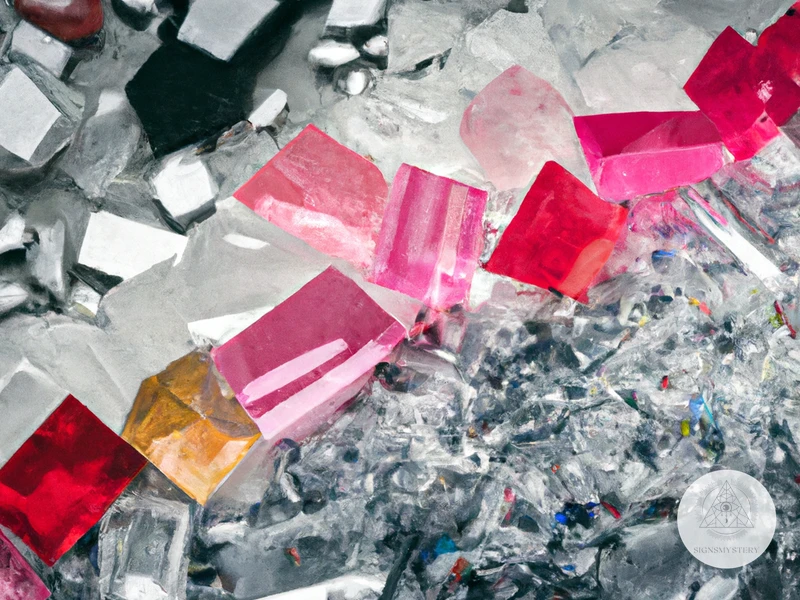
1. Educate Yourself on Genuine Crystals: The first step in avoiding fake crystals is to arm yourself with knowledge. Take the time to research and familiarize yourself with the characteristics of genuine crystals. Learn about the different types of crystals, their formations, colors, and properties. Understanding the unique attributes of specific crystals can help you identify any inconsistencies or suspicious characteristics in the fake ones.
2. Purchase from Reputable Sources: When it comes to buying crystals, it is essential to choose trustworthy and reputable sources. Seek out established crystal dealers, specialized crystal shops, or established online marketplaces known for their authenticity and quality. Read customer reviews and look for certifications or guarantees of authenticity. Be cautious of deals that seem too good to be true, as counterfeit crystals are often found in bargain bins or sold at incredibly low prices.
In conclusion, by educating yourself about genuine crystals and purchasing from reputable sources, you significantly reduce the risk of buying fake crystals. Remember that genuine crystals may come with a higher price tag, as their quality and authenticity are worth the investment. Trust your intuition and be cautious of any red flags when making crystal purchases. By taking these precautions, you can ensure that the crystals you bring into your life are authentic, beautiful, and truly beneficial.
1. Educate Yourself on Genuine Crystals
1. Educate Yourself on Genuine Crystals: It is essential to have a good understanding of genuine crystals in order to distinguish them from fake counterparts. Here are some key steps to educate yourself on genuine crystals:
- Research Crystal Types: Familiarize yourself with the different types of crystals available in the market. Each crystal has unique properties, colors, and formations. Understanding these characteristics will help you identify genuine crystals.
- Study Crystal Formation: Genuine crystals have a distinct natural formation process. Research how crystals are naturally created and examine their internal structures. This knowledge will assist you in spotting any irregularities or unnatural formations in fake crystals.
- Learn Crystal Properties: Genuine crystals are known for their metaphysical and healing properties. Explore the specific properties associated with different crystals, such as their ability to promote love, enhance intuition, or provide protection. This knowledge will help you differentiate genuine crystals from imitations.
- Consult Expert Guides and Books: Utilize trusted resources such as expert guides, books, and online resources that provide detailed information about genuine crystals. These sources will provide you with valuable insights and guidance on identifying authentic crystals.
- Attend Workshops and Events: Consider attending workshops, seminars, or crystal fairs where experts share their knowledge and expertise on genuine crystals. These events offer an excellent opportunity to learn from experienced individuals and gain hands-on experience with authentic crystals.
By arming yourself with knowledge and education, you can confidently navigate the world of crystals and make informed decisions when purchasing them. Remember, genuine crystals possess unique qualities and characteristics that set them apart from their fake counterparts.
2. Purchase from Reputable Sources
When it comes to buying crystals, it is crucial to purchase from reputable sources to ensure authenticity and quality. With the rise of fake crystals in the market, it’s essential to be cautious and discerning in your purchase decisions. Here are some tips to help you purchase from reputable sources:
1. Seek Recommendations: Seek recommendations from friends, family, or other crystal enthusiasts who have had positive experiences with specific sellers or vendors. Personal recommendations can be invaluable in identifying trustworthy sources.
2. Research the Seller: Before making a purchase, take the time to research the seller or vendor. Look for established and reputable businesses that have a strong online presence and positive customer reviews. Avoid sellers with numerous complaints or negative feedback.
3. Verify Certifications: Reputable sellers often provide certifications or guarantees of authenticity for their crystals. Look for certifications from gemological institutes or organizations that specialize in crystal authentication. These certifications offer assurance that you are purchasing genuine crystals.
4. Customer Support and Return Policy: A reliable seller will have excellent customer support and a clear return policy. They will be responsive to inquiries and concerns, and they will offer a fair return or exchange policy in case you are not satisfied with your purchase.
5. Educate Yourself: Knowledge is power when it comes to purchasing crystals. Educate yourself about the specific crystals you are interested in, their characteristics, and common imitations. This knowledge will help you spot discrepancies and make informed purchasing decisions.
By purchasing from reputable sources, you can have confidence in the authenticity and quality of your crystals. This ensures that you are investing in genuine pieces that possess the desired energetic properties and beauty. Remember to exercise caution, do your research, and trust your instincts when purchasing crystals to avoid falling victim to fake or low-quality imitations.
Conclusion
Crystals, with their alluring beauty and perceived metaphysical properties, have captured the hearts and minds of people for centuries. However, alongside the genuine crystal market, a parallel market for fake crystals has emerged. This guide has explored the appeal of crystals, including their connection to nature, their aesthetic and decorative purposes, and their potential for healing and holistic practices.
We also delved into the rise of the market for fake crystals, which can be attributed to increased popularity and demand, lack of regulation in the industry, and the profit motive behind these imitations. We discussed how to spot fake crystals by examining their appearance, texture, and properties, as well as testing for authenticity.
Furthermore, we explored the market for fake crystals, which encompasses online marketplaces and websites, physical stores and vendors, and the influence of social media and influencers. It’s crucial to exercise caution and educate ourselves on genuine crystals to avoid falling prey to scams and purchasing fake crystals.
In conclusion, understanding the market for fake crystals is essential for crystal enthusiasts and those interested in investing in authentic crystals. By arming ourselves with knowledge, we can navigate the crystal market with confidence, ensuring that we make informed purchases from reputable sources. Crystals have a unique and captivating energy that holds immense value, and by staying vigilant, we can continue to enjoy their beauty and harness their potential for healing and spiritual growth.
Frequently Asked Questions
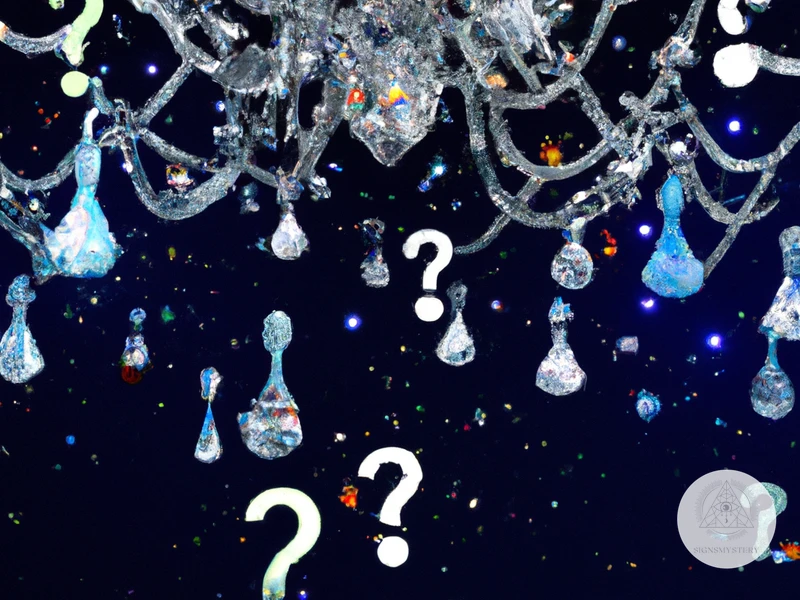
1. Are all crystals natural formations?
No, not all crystals are natural formations. There are synthetic or lab-grown crystals that are created in a controlled environment to mimic the properties of natural crystals.
2. How long have crystals been used for spiritual and healing purposes?
The use of crystals for spiritual and healing purposes dates back thousands of years. Ancient civilizations like the Egyptians, Greeks, and Romans incorporated crystals into their rituals and belief systems.
3. Can crystals really affect my energy or mood?
While the effects of crystals on energy and mood are subjective and vary from person to person, many individuals believe that crystals have the potential to positively influence emotions and energy levels.
4. How can I cleanse and recharge my crystals?
There are several methods to cleanse and recharge crystals, such as placing them under running water, burying them in the earth, or using other crystals like clear quartz to amplify their energy (link to /cleanse-recharge-tigers-eye-crystals/).
5. What is the significance of crystal shapes and formations?
The shape and formation of a crystal can affect its energy and properties. Different shapes, such as points, clusters, and geodes, can influence the way energy flows and interacts with the crystal.
6. Are there any scientific studies supporting the healing properties of crystals?
While scientific studies on crystals’ healing properties are limited, there is growing interest in the field of vibrational medicine. Some studies suggest that crystals may have an effect on the human energy field, but more research is needed.
7. How can I differentiate between a real crystal and a fake one?
Examining the appearance, texture, and properties of a crystal can help differentiate between a real crystal and a fake one. Additionally, testing methods like the scratch test, density test, or using a UV light can provide further clues to authenticity.
8. Why are some crystals more expensive than others?
The price of a crystal can be influenced by factors such as rarity, quality, size, and demand. Rare crystals or those with unique properties may command higher prices in the market.
9. Can I buy genuine crystals online?
Yes, you can buy genuine crystals online, but it’s important to purchase from reputable sources. Look for sellers with good reviews, certifications, and transparent information about the crystals they sell.
10. How can I use crystals in my everyday life?
There are numerous ways to incorporate crystals into your everyday life. You can carry them in your pocket or wear them as jewelry, place them in your home or office for positive energy, meditate with them, or use them during healing practices.
References
Frequently Asked Questions

1. How can crystals benefit our spiritual practices?
Crystals are believed to have unique energies that can enhance our spiritual practices by promoting relaxation, focus, and self-reflection. They are often used in meditation, energy healing, and creating sacred spaces.
2. Can fake crystals provide the same spiritual benefits as genuine ones?
Fake crystals lack the natural properties and energies of genuine crystals, so they are unable to provide the same spiritual benefits. Their presence may offer a placebo effect, but for true spiritual practices, it’s best to opt for authentic crystals.
3. Are fake crystals harmful or dangerous?
Fake crystals themselves are not inherently harmful or dangerous. However, if someone purchases fake crystals instead of genuine ones for healing purposes, they may miss out on the potential healing effects offered by real crystals.
4. How can I differentiate between fake and genuine crystals?
There are several ways to spot fake crystals, including examining their appearance, texture, and properties. Authenticity tests, such as performing a scratch test or using specific tools like a magnifying glass, can also help determine the authenticity of a crystal.
5. What are some common indicators of fake crystals?
Common indicators of fake crystals include an unnaturally perfect appearance, lack of imperfections or inclusions, uniform color, and low weight compared to their size. Additionally, crystals made from glass or resin are often considered fake.
6. Where can I find reliable sources to purchase genuine crystals?
Reputable sources for purchasing genuine crystals include well-established crystal shops, certified gemstone retailers, and online platforms that guarantee authenticity. It’s important to do proper research and read customer reviews before making a purchase.
7. Are there any certifications or standards for authentic crystals?
While there is no universal certification or standard specifically for crystals, reputable sellers may provide documentation, such as a certificate of authenticity or information about the crystal’s origin and properties. It’s essential to ensure the seller’s credibility before relying solely on certification.
8. Are all crystals used for healing purposes genuine?
No, not all crystals used for healing purposes are genuine. The healing properties associated with crystals are often based on their unique natural energies. Fake crystals lack these energies, making them less effective in holistic healing practices.
9. Can I trust crystals sold by influencers or online marketplaces?
While there are trustworthy influencers and online marketplaces that sell genuine crystals, it’s important to exercise caution. Do thorough research on the influencer or seller, check for customer reviews, and validate their credibility before making a purchase.
10. Are all crystals labeled as “fake” intended to deceive buyers?
No, not all crystals labeled as “fake” are intended to deceive buyers. Some sellers openly offer synthetic or man-made crystals, which may have aesthetic appeal but lack the natural properties of genuine crystals. It’s crucial to read product descriptions carefully to ensure transparency.

